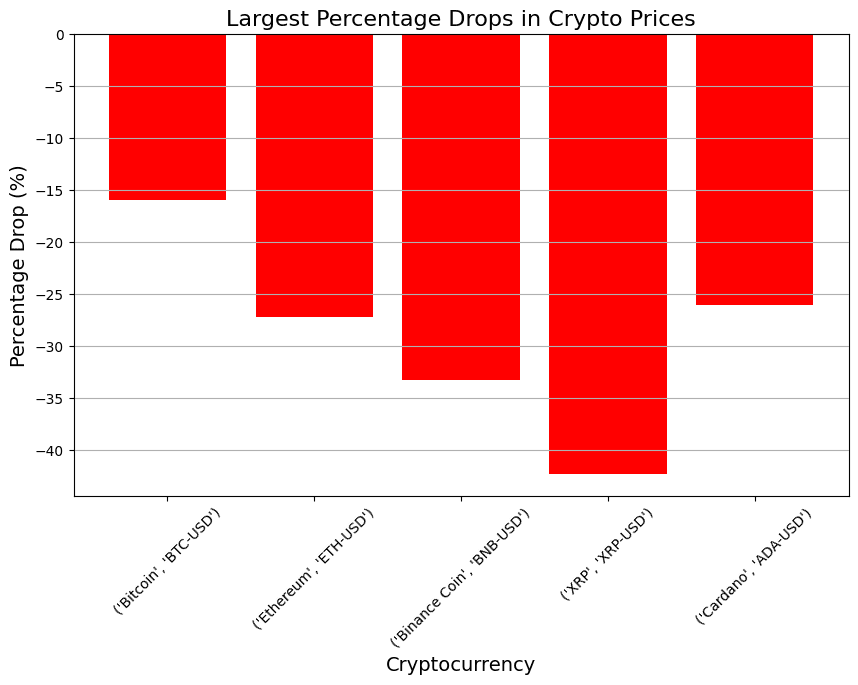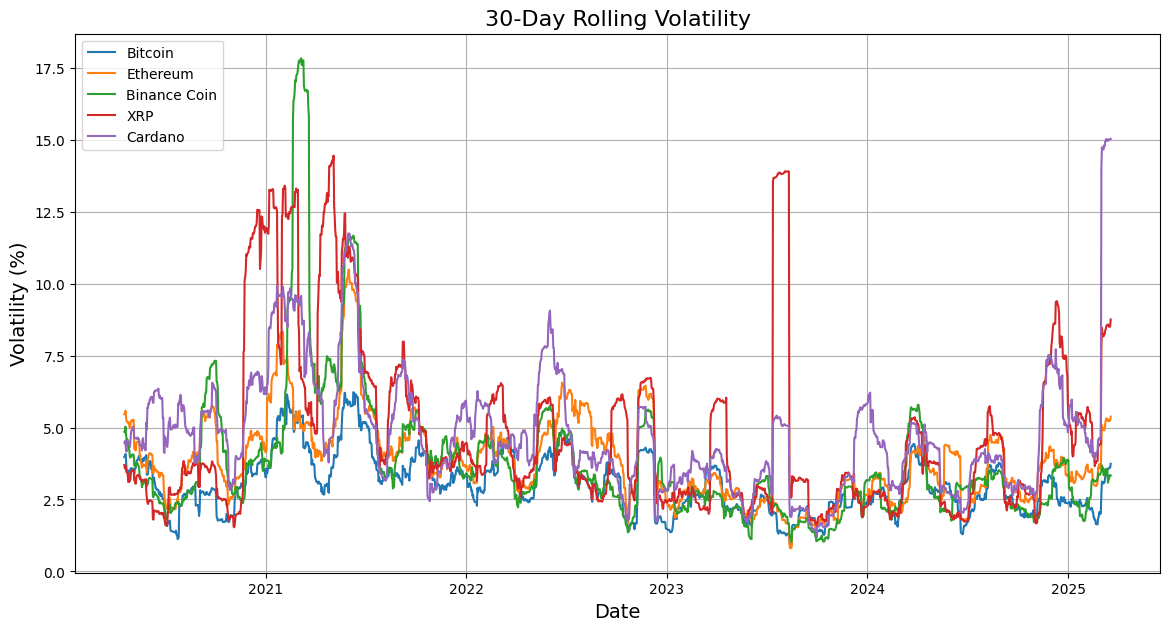In recent years, cryptocurrencies have become one of the most discussed asset classes (some may urge that its not one), capturing my attention and that of investors worldwide due to their volatility and potential for high returns. I’ve analyzed the performance of five major cryptocurrencies i.e. Bitcoin (BTC-USD), Ethereum (ETH-USD), Binance Coin (BNB-USD), XRP (XRP-USD), and Cardano (ADA-USD) over the past five years. By examining key statistics, including price trends, volatility, maximum drawdowns, and risk-adjusted returns, I have gained a better understanding of how these digital assets have performed.

Key Statistics Overview
The dataset I’ve reviewed spans 1,827 days, providing a comprehensive look at the price movements of these cryptocurrencies. I’ve observed that Bitcoin leads the pack with an average price of 39,993.55, followed by Ethereum at 2,092.87. Binance Coin, XRP, and Cardano have significantly lower average prices, reflecting their smaller market caps. I have noted (almost seems obvious if you have been following the markets) that Bitcoin and Ethereum show the highest volatility, with standard deviations of 23,394.64 and 1,098.46, respectively. This highlights the inherent risk in these assets, as prices can swing dramatically in short periods. Bitcoin’s price has ranged from a low of 5,830.25 to a high of 106,146.27, showcasing its explosive growth during bull markets. On the other hand, Cardano had the lowest minimum price at just 0.027 , but it also saw significant growth, reaching a peak of 2.97.

Largest Percentage Drops and Maximum Drawdowns
Almost everyone knows that cryptocurrencies are notorious for their sharp declines, and the data I’ve analyzed confirms this. I found that XRP experienced the steepest single drop at -42.33%, followed by Binance Coin at -33.27%. Bitcoin, often considered the most stable crypto, had the smallest drop at -15.97%. Cardano takes the crown for the worst drawdown, plummeting -91.85% from its peak. XRP and Ethereum weren’t far behind, with drawdowns of -83.25% and -79.35%, respectively. Bitcoin’s maximum drawdown was -76.63%, still significant but slightly better than its peers. These figures underscore the high risk nature of cryptocurrencies. While they offer substantial upside potential, I’ve realized that investors must be prepared for steep losses during market downturns.

Total and Annualized Returns
Despite the volatility, I’ve found that cryptocurrencies have delivered impressive returns over the past five years. Yes, usually there will be opportunities to make money in highly volatile environments – not for the faint hearted. Binance Coin leads with a staggering 572.62% return, followed closely by Cardano at 572.25% and XRP at 557.37%. Ethereum and Bitcoin also performed well, with returns of 429.42% and 357.15%, respectively. Binance Coin again tops the list with an annualized return of 114.46%, meaning an investment in BNB would have more than doubled every year on average. Cardano and XRP also delivered triple digit annualized returns, while Bitcoin and Ethereum trailed slightly but still posted impressive gains. These returns highlight the transformative potential of cryptocurrencies as an asset class. However, I’ve learned that past performance is not indicative of future results, and the crypto market remains highly unpredictable.
I looked at the annualized returns and total percentage returns which offer distinct insights into cryptocurrency performance. Total percentage returns reflect cumulative growth over the entire five year period, with Bitcoin delivering 357.15% and Binance Coin and Cardano leading at 572.62% and 572.25%, respectively. Annualized returns, however showed the average yearly growth rate, accounting for compounding, with Bitcoin at 71.39% and Binance Coin and Cardano at 114.46% and 114.39%. While total returns show overall growth, annualized returns standardize performance to a yearly basis, making them ideal for comparing investments over different time frames. The high annualized returns of Binance Coin and Cardano highlight their ability to deliver consistent, substantial growth year after year, even as their total returns remain equally impressive.

Risk Adjusted Performance
To assess whether these returns justify the risks, I’ve used the Sharpe Ratio, which measures return per unit of risk or volatility. I found that Binance Coin has the highest Sharpe Ratio at 1.32, indicating it delivered the best risk adjusted returns. Bitcoin follows at 1.17, with Cardano and Ethereum close behind. XRP has the lowest Sharpe Ratio at 1.01, suggesting it offered slightly less compensation for its risk. While all five cryptocurrencies have Sharpe Ratios above 1, indicating positive risk adjusted returns, Binance Coin stands out as the most efficient performer.
From my analysis, I’ve concluded that cryptocurrencies have delivered extraordinary returns over the past five years, but they come with significant risks, as evidenced by their large drawdowns and volatility. While Bitcoin and Ethereum are often seen as the blue chips of the crypto world, smaller coins like Binance Coin and Cardano have outperformed them in terms of total and annualized returns. However, they also come with higher risk. Binance Coin and Bitcoin offer the best risk adjusted returns, making them potentially more attractive for risk averse investors. The crypto market is still young and highly speculative, and investors should be prepared for wild price swings, only investing what they can afford to lose.
Cryptocurrencies have proven to be a lucrative but unpredictable asset class. While the past five years have been marked by incredible growth, I believe the future remains uncertain. Regulatory changes, technological advancements, and market sentiment will continue to play a significant role in shaping the crypto landscape. For me, the key is to approach this market with caution, conduct thorough research, and maintain a long term perspective depending on whether you’re a seasoned trader or a curious newcomer. Understanding the risks and rewards of cryptocurrencies is essential to navigating this exciting but volatile space.

Crypto Developments in the US
Looking at the USA as a driver of the global economy, the US has seen significant developments in the cryptocurrency space, which could have far reaching implications for the market. The Securities and Exchange Commission has been working to provide clearer guidelines for cryptocurrencies, fostering greater institutional adoption in the long run. The approval of Bitcoin and Ethereum ETFs has been a major milestone, allowing traditional investors to gain exposure to crypto without directly holding the assets. Congress has also been debating several bills aimed at regulating the crypto industry, such as the Digital Asset Market Structure and Investor Protection Act, which seeks to define the roles of the SEC and the Commodity Futures Trading Commission in overseeing digital assets.
In addition , major financial institutions, such as BlackRock and Fidelity, have deepened their involvement in the crypto space. BlackRock’s application for a Bitcoin ETF and Fidelity’s plans to offer crypto trading to retail investors signal growing mainstream acceptance. Meanwhile, the Federal Reserve has been exploring the development of a digital dollar, which could reshape the financial system and impact the role of decentralized cryptocurrencies. Environmental concerns have also come to the forefront, with the energy consumption of cryptocurrency mining drawing scrutiny from policymakers.
To wrap it up, the cryptocurrency market continues to evolve rapidly, with both opportunities and challenges on the horizon. While the past five years have demonstrated the transformative potential of digital assets, the future will depend heavily on regulatory developments, technological innovation, and market dynamics. For investors, staying informed and adopting a cautious, long-term approach will be key to navigating this exciting but unpredictable space. As the US takes steps toward greater regulation and institutional adoption, the crypto landscape is poised for further growth and maturation.
For more articles
Simon Peter Mulima

Thanks for sharing this valuable post! Quick heads-up— the cheapest cloud web hosting just dropped its prices even further, but only until April 17th! Snag this unbeatable deal before it’s gone!